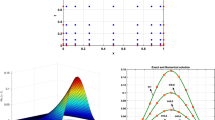Abstract
In this paper, we consider a new direction for generating and simultaneously solving equations of motion for dynamical systems, using automatic differentiation. We overview the current computational approaches for solving multibody dynamics problems and discuss several choices for equation of motion formulation. We present an operator-overloading method for generating equations of motion automatically via Lagrange’s Equations and solve them in a direct fashion. Several numerical examples are presented to demonstrate the accuracy and efficiency of the method for simulating the motion of multibody dynamical systems.
Similar content being viewed by others
References
GRIFFITH, D. T., SINCLAIR, A. J., TURNER, J. D., HURTADO, J. E., and JUNKINS, J. L. “Automatic Generation and Integration of Equations of Motion by Operator-Overloading Techniques,” presented as paper AAS 04–242 at the AAS/AIAA Spaceflight Mechanics Meeting, Maui, HI, February 8–12, 2004.
GRIFFITH, D. T., JUNKINS, J. L., and TURNER, J. D. “Automatic Generation and Integration of Equations of Motion for Linked Mechanical Systems,” presented at the 6th International Conference on Dynamics and Control of Systems and Structures in Space, July 18–22, 2004, Riomaggiore, Cinque Terre, Liguria, Italy.
GRIFFITH, D. T. New Methods for Estimation, Modeling and Validation of Dynamical Systems Using Automatic Differentiation, Ph.D. Dissertation, Texas A&M University, 2004.
DURRBAUM, A., KLIER, W., and HAHN, H. “Comparison of Automatic and Symbolic Differentiation in Mathematical Modeling and Computer Simulation of Rigid Body Systems,” Multibody System Dynamics, Vol. 7, 2002, pp. 331–355.
TURNER, J. D. “Quaternion-Based Partial Derivative and State Transition Matrix Calculations for Design Optimization,” presented at the 40th AIAA Aerospace Sciences Meeting and Exhibit, Reno, Nevada, January 14–17, 2002.
TURNER, J. D. “Object Oriented Coordinate Embedding Algorithm for Automatically Generating the Jacobian and Hessian Partials of Nonlinear Vector Functions,” Invention Disclosure, University of Iowa, May 2002.
TURNER, J. D. “The Application of Clifford Algebras for Computing the Sensitivity Partial Derivatives of Linked Mechanical Systems,” presented at the USNCTAM14: Fourteenth U.S. National Congress of Theoretical and Applied Mechanics, Blacksburg, Virginia, USA, June 23–28, 2002.
TURNER, J. D. “Automated Generation of High-Order Partial Derivative Models,” AIAA Journal, Vol. 51, No. 8, August 2003, pp. 1590–1598.
TURNER, J. D. “Generalized Gradient Search and Newton’s Methods for Multilinear Algebra Root-Solving and Optimization Applications,” presented as paper AAS 03–261 at the John L. Junkins Astrodynamics Symposium, George Bush Conference Center, College Station, Texas, May 23–24, 2003.
TURNER, J. D. “Generalized Gradient Search and Newton’s Methods for Multilinear Algebra Root-Solving and Optimization Applications,” The John L. Junkins Astrodynamics Symposium, Advances in the Astronautical Sciences, Vol. 115, 2003, pp. 55–78.
BARUH, H. Analytical Dynamics, McGraw Hill, New York, 1998.
SCHAUB, H. and JUNKINS, J. L. Analytical Mechanics of Space Systems, AIAA, Reston, VA, 2003.
BANERJEE, A. K. “Contributions of Multibody Dynamics to Space Flight: A Brief Review,” Journal of Guidance, Control, and Dynamics, Vol. 26, No. 3, May-June 2003, pp. 385–394.
SCHIEHLEN, W. (editor) Multibody Systems Handbook, Springer-Verlag, New York, 1990.
SHABANA, A. A. Computational Dynamics, Second Edition, John Wiley and Sons, New York, 2001.
GARCIA DE JALON, J. and BAYO, E. Kinematic and Dynamic Simulation of Multibody Systems: The Real-Time Challenge, Springer-Verlag, New York, 1994.
HUSTON, R. L. Multbody Dynamics, Butterworth-Heinemann, New York, 1990.
LEE, M. G. “Application of Automatic Differentiation in Numerical Solution of a Flexible Mechanism,” Proceedings of the International Conference on Computational Methods in Science and Engineering, Kastoria, Greece, September 12–16, 2003, pp. 350–359.
JUNKINS, J. L. and KIM, Y. Introduction to Dynamics and Control of Flexible Structures, AIAA Education Series, Washington, DC, 1993.
REDDY, J. N. An Introduction to the Finite Element Method, McGraw-Hill, New York, 1993.
THOMSON, W. T. and DAHLEH, M. D. Theory of Vibration with Applications, Prentice Hall, New Jersey, 1998.
BARUH, H. and RADISAVLJEVIC, V. “Modeling of Flexible Mechanisms by Constrained Coordinates,” Journal of the Chinese Society of Mechanical Engineers, Vol. 21, No. 1, 2000, pp. 1–14.
Author information
Authors and Affiliations
Rights and permissions
About this article
Cite this article
Griffith, D.T., Turner, J.D. & Junkins, J.L. Automatic Generation and Integration of Equations of Motion for Flexible Multibody Dynamical Systems. J of Astronaut Sci 53, 251–279 (2005). https://doi.org/10.1007/BF03546353
Published:
Issue Date:
DOI: https://doi.org/10.1007/BF03546353




